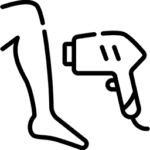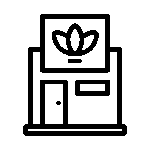Add Keywords to Website: Boost SEO & Attract More Visitors

Adding keywords to your website isn't complex tech wizardry. It's an actionable marketing task: placing the right words in the right places on your site. This simple act tells search engines what your business is about, connecting you with customers who are actively searching for your services on Google.
Think of Keywords as Your Digital Welcome Mat
Imagine your business is located on a busy street. Without a clear sign, potential customers will walk right by. Keywords are your website's digital sign, telling Google and potential clients what you offer. This is the foundation of getting found online, and it's a skill you can master.

This guide provides a straightforward, actionable plan to make your website an effective marketing tool. By strategically placing the right words, you're rolling out a digital welcome mat that brings a steady stream of ready-to-buy customers directly to you. Forget complicated theories; these are simple, effective changes you can implement today.
The whole point is to make your website more visible, which in turn makes it more profitable. You can dig into some more proven SEO strategies to boost organic traffic to see how all the pieces fit together.
This process is a core part of what is search engine optimization and is key to turning your website from a simple online brochure into a customer-generating machine. The impact is significant—around 53% of all website traffic comes from organic search. That’s more than half your potential customers.
Finding the Words Your Clients Actually Use
Before you can add keywords, you must understand what your customers are typing into Google. This isn’t guesswork; it's about discovering the exact language your target audience uses.
Start by brainstorming. List your services, but think like a customer. Instead of just "manicure," they might search for "gel manicure in Austin" or "no-chip pedicure downtown." This initial list is your starting point for keyword research.
Now, let's refine this list to uncover how people search for what you offer.

Uncovering Hidden Keyword Opportunities
Your best keyword ideas often come from where your customers are already talking.
- Analyze Your Competitors: Visit the websites of your top competitors. What services do they highlight? What words do they use in their headlines and service descriptions? This gives you a quick snapshot of terms that are already working in your industry and area.
- Read Online Reviews: Google and Yelp reviews are a goldmine. Pay attention to the specific words customers use when describing services. You might find valuable phrases you hadn't considered, like "best salon for natural balayage" or "gentle waxing for sensitive skin."
These longer, more specific phrases are called long-tail keywords. They are valuable because they indicate the searcher knows exactly what they want and is often ready to make a purchase.
Keyword research is still the foundation of any good SEO strategy. In fact, these super-specific long-tail keywords make up around 70% of all search traffic. They usually have less competition and much higher conversion rates, making them the perfect way to attract clients who are ready to pull out their credit cards.
Building Your Master Keyword List
Organize your findings in a simple spreadsheet. Create columns for the "Keyword," its monthly "Search Volume" (an estimate of how many people search for it), and "Where to Use" (e.g., Homepage, Service Page, Blog Post). This list will become your roadmap for placing keywords effectively.
For search volume data, you can use comprehensive SEO tools like Semrush. Many free tools are also available.
This organized list is your guide for where to place each keyword for maximum impact. Here’s a quick reference table to help you plan.
Your Keyword Placement Cheat Sheet
| Keyword Type | Example | Where It Works Best |
|---|---|---|
| Primary Keywords | "hair salon Austin" | Page Titles, H1 Headings, URL, Meta Description |
| Secondary Keywords | "balayage highlights Austin" | Subheadings (H2, H3), Body Copy, Service Descriptions |
| Long-Tail Keywords | "best salon for blonde balayage downtown Austin" | Blog Posts, FAQ Pages, Specific Service Pages |
| Local Keywords | "nail salon near South Congress" | Homepage, Contact Page, Google Business Profile |
| Image Keywords | "modern salon interior design" | Image Alt Text, File Names |
Use this as a guide for adding keywords throughout your site in a way that feels natural to readers and makes sense to Google.
5 High-Impact Places to Add Keywords on Your Website
You have your keyword list. Now, let's put it to work. You don't need to be a web developer to make these changes. Here are the five most important places to add keywords on your website, no matter which platform you use (like Wix, Squarespace, or Shopify).
Placing keywords in these "prime real estate" spots sends the strongest signals to Google and potential customers about what your page offers.
1. Page Titles and Meta Descriptions
Your page title (also called a title tag) and meta description are what people see in Google search results. A strong, keyword-rich title encourages clicks, while a generic one gets ignored.
A title like "Services" is a missed opportunity. Let's make it better.
- Before: Services
- After: Expert Lash Extensions & Brow Tinting in Chicago
The "After" version clearly communicates your services, expertise, and location. It tells both Google and your ideal client exactly what to expect, making them far more likely to click.
Want to really master this part? Getting your meta description right is crucial. For a deeper dive, check out this fantastic guide on how to write meta descriptions.
2. Headings and Body Paragraphs
Once a visitor is on your site, headings (H1s, H2s, etc.) act as signposts. They break up your content, make it easy to scan, and show search engines the page's structure and main topics.
- H1 (Main Heading): Use your primary keyword here. You should only have one H1 per page.
- H2s & H3s (Subheadings): Use secondary and related keywords to organize your content logically.
When writing your main paragraphs (body copy), your goal is to sound natural, not robotic. Write for humans first, Google second. Instead of repeating "best facial in SoHo," weave it into your story. For example, describe your signature treatment and mention how clients have called it the "best facial in SoHo."
This infographic shows how a primary keyword connects all the elements of a page.

It all starts with one powerful keyword that guides the optimization of the entire page.
3. Image Alt Text
A frequently overlooked spot for keywords is image alt text. This is a short, written description of an image that serves two key purposes: it helps search engines understand your photos, and it improves accessibility for visually impaired users.
Instead of a generic filename like IMG_4056.jpg, use a descriptive name and add descriptive alt text.
- Bad Alt Text: "woman getting facial"
- Good Alt Text: "Client receiving a hydrating hydrofacial at our downtown Chicago spa"
This simple step helps your images appear in Google Image Search and reinforces your page's topic. It’s another valuable opportunity to add keywords to your website.
Using Search Intent to Attract Ready-to-Buy Clients
Placing keywords is the first step. Understanding why a customer searched for those words is the secret to success. This is called search intent. When you match your content to the user's intent, you connect with customers at the right moment.
For example, someone searching "how to remove gel polish" is looking for information. But someone searching "book a gel manicure near me" is ready to buy. Your goal is to capture that second customer. This means prioritizing keywords with transactional intent on your main service pages.

Hunting for High-Intent Keywords
How do you identify these valuable keywords? Look for phrases that imply action or are tied to a specific location.
- Transactional Keywords: "book balayage Austin," "lash lift prices Chicago," "buy gift certificate for spa day"
- Informational Keywords: "what is a hydrafacial," "how long do lash extensions last," "DIY nail art"
While informational keywords are useful for blog posts and guides, your service pages must focus on transactional terms. These are the keywords that attract clients ready to book an appointment now.
By mid-2025, using AI-powered SEO tools to figure this stuff out has become totally standard. AI makes it way easier to sort keywords by whether someone is just browsing for info or is ready to make a purchase. This helps salons and spas create content that perfectly matches what people are looking for. You can get more insights on this from the latest AI SEO statistics from seo.com.
Answering Questions to Build Trust
Don't ignore those informational "how-to" searches. They are an excellent way to connect with potential customers early in their decision-making process.
Create blog posts or FAQ pages that answer common questions. For instance, a blog post titled "How to Make Your Balayage Last Longer" solves a real problem for your target audience. This positions you as an expert and builds trust. When it's time for their next hair appointment, your business will be the first one they think of.
Common Keyword Mistakes That Hurt Your Ranking
As you begin adding keywords, it's easy to make simple mistakes that can harm your SEO efforts. Here are two common pitfalls to avoid.
The biggest mistake is keyword stuffing. This is the practice of cramming keywords into a page repeatedly until the text sounds unnatural and is difficult to read. This creates a poor user experience, and Google may penalize your site for it.
Another common error is targeting keywords that are too broad. A term like "beauty salon" is extremely competitive, making it difficult for a local business to rank. You will achieve better results by focusing on specific, local keywords like "best balayage artist in SoHo" that attract customers in your service area.
Thinking SEO Is a One-and-Done Task
Finally, remember that SEO is not a one-time project; it is an ongoing process. Search trends change, competitors update their strategies, and Google constantly refines its algorithms.
The most effective approach is to view SEO as a core part of your business growth. It’s not just about adding words; it’s about consistently refining your strategy to stay visible and relevant to your ideal clients.
Regularly review your keyword performance and make adjustments to ensure long-term success. Avoiding these common mistakes will help your hard work pay off. For more inspiration, check out our guide on creative hair salon marketing ideas.
Your Burning Keyword Questions, Answered
As you start working with keywords, questions will naturally arise. Here are answers to two of the most common ones business owners ask.
How Many Keywords Should I Focus On Per Page?
While there is no single magic number, a good rule of thumb is to focus on one primary keyword for each page. This keyword should represent the page's main topic. For example, on a page about gel manicures, your primary keyword might be "gel manicures in Austin."
You can then include three to five secondary keywords. These are variations or related terms that support the main topic, such as "no-chip manicure Austin" or "long-lasting gel polish." Weave these naturally into your headings and body text.
The goal here is clarity, not clutter. Don't try to make one page rank for ten different services. It just confuses Google and dilutes your message, making it tough to rank for anything at all.
How Often Should I Use My Main Keyword?
Focus on natural placement rather than a specific number of repetitions. If your writing sounds forced or robotic, you've used the keyword too many times. A helpful tip is to read your content out loud to check its flow.
As a general guideline, ensure your primary keyword appears in these key locations:
- The main page heading (H1) and the SEO title tag.
- Within the first paragraph, preferably in the first sentence.
- In at least one subheading (e.g., an H2).
- In the alt text for at least one relevant image.
- Once or twice more naturally within the body content.
Remember, you are writing for your customers first. Keyword stuffing will turn off potential clients and can lead to penalties from search engines. Focus on creating valuable, helpful content, and the keywords will fit in naturally.
Ready to build a beautiful website that actually gets found by your dream clients? The team at gohappybeauty specializes in creating stunning, SEO-optimized sites specifically for beauty professionals like you. Start building your dream website today!
Grow your beauty business
Our focus is, and always will be, helping you improve your online presence and generate more business from your website. That is what we do, for you.

